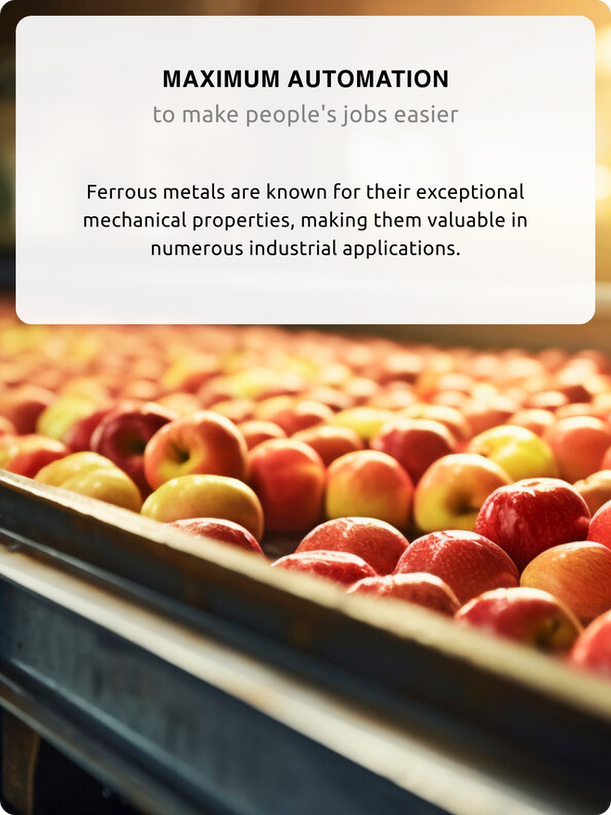
Food
Ai-feature
sorting
Driving performance in food processing
Tight margins and strict safety standards make precision sorting essential to profitability. InSystem optical sorting machines improve yield, reduce giveaway, and maintain consistent product quality at scale. AI-driven vision technology detects the smallest defects and contaminants, ensuring compliance and minimizing loss before packaging.
Operational benefits

HIGH SORTING ACCURACY
Finds even small defects
Stable quality and fewer rejects help you get more good product from every batch.

HIGH SPEED
Stays fast even at full load
The system keeps a steady flow during busy hours, helping you hit daily output targets.

MAXIMUM AUTOMATION
Adjusts for each product
Less manual setup between runs saves time and keeps the line running smoothly.

Insystem
sorting line
Each line is built for continuous operation in demanding production environments. Modular design allows future adjustments to capacity or layout without major reconfiguration.
Types of sorting
on our equipment


Setting category criteria
The sorter compares objects to user-defined accept/reject criteria to identify and remove defective products and foreign material (FM) from the production line, or to separate product of different grades or types of materials.

Recognizing pieces with the camera
Depending on the types of sensors used and the software-driven intelligence of the image processing system, optical sorters can recognize an object's characteristics:
color
size
shape
strucaral properties
chemical composition

Sorting into 2+ segments
Compared to manual sorting, which is subjective and inconsistent, optical sorting helps improve product quality, maximize throughput and increase yields while reducing labor costs.
2 type
SMALL AND SOFT FRUITS AND BERRIES


MicroSort
SCU: 0601

Uploading material to tape
Loading material onto the belt.

Separation
Materials are categorized according to their size, shape, color, etc.

Sorting into 2 or 6 segments
Compared to manual sorting, which is subjective and inconsistent, optical sorting helps improve product quality, maximize throughput and increase yields while reducing labor costs.


Driving performance in food processing
Tight margins and strict safety standards make precision sorting essential to profitability. InSystem optical sorting machines improve yield, reduce giveaway, and maintain consistent product quality at scale. AI-driven vision technology detects the smallest defects and contaminants, ensuring compliance and minimizing loss before packaging.
Improving & safeguarding food production
Stricter food safety regulations and growing consumer demand for visually perfect, high-quality products are driving the need for advanced sorting technologies. Innovations such as machine vision, AI, and hyperspectral imaging are significantly enhancing sorting precision by detecting subtle defects, contaminants, and optimal ripeness.

Types of ore sorting on our equipment
1 type
MEDIUM SIZE FRUITSAND VEGITABLES


Setting category criteria
The sorter compares objects to user-defined accept/reject criteria to identify and remove defective products and foreign material (FM) from the production line, or to separate product of different grades or types of materials.

Recognizing pieces with the camera
Depending on the types of sensors used and the software-driven intelligence of the image processing system, optical sorters can recognize an object's characteristics:
color
size
shape
strucaral properties
chemical composition

Sorting into 2+ segments
Compared to manual sorting, which is subjective and inconsistent, optical sorting helps improve product quality, maximize throughput and increase yields while reducing labor costs.
2 type
SMALL AND SOFT FRUITS
AND BERRIES


Uploading material to tape
Loading material onto the belt.

Separation
Materials are categorized according to their size, shape, color, etc.

Sorting into 2 or 6 segments
Compared to manual sorting, which is subjective and inconsistent, optical sorting helps improve product quality, maximize throughput and increase yields while reducing labor costs.

microsort
SCU: 0802


.png)
Setting category criteria
The sorter compares objects to user-defined accept/reject criteria to identify and remove defective products and foreign material (FM) from the production line, or to separate product of different grades or types of materials.
.png)
Recognizing pieces with the camera
Depending on the types of sensors used and the software-driven intelligence of the image processing system, optical sorters can recognize an object's characteristics:
color
size
shape
strucaral properties
chemical composition
.png)
Sorting into 2+ segments
Compared to manual sorting, which is subjective and inconsistent, optical sorting helps improve product quality, maximize throughput and increase yields while reducing labor costs.

.jpg)

2 type
Ballistic separation


MicroSort
SCU: 0802
.png)
Uploading material to tape
Loading material onto the belt.
.png)
Separation with grids
Materials are categorized according to their size. The overall flow flies through several stages, each characterized by the size of the hole in the mesh into which the material can fall.
.png)
Sorting into 2 or 6 segments
Compared to manual sorting, which is subjective and inconsistent, optical sorting helps improve product quality, maximize throughput and increase yields while reducing labor costs.












.png)
.png)
.png)